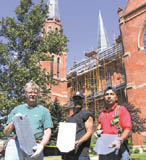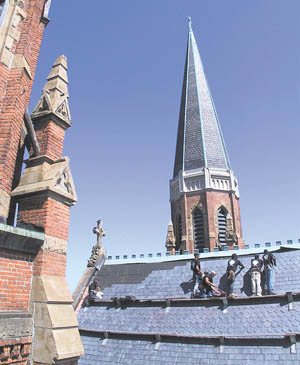116-year life-span for a roof? St. Anne's got its money's worth
Date Posted: September 14 2001
A combination of quality construction materials and great craftsmanship helped the slate roof of St. Anne's Church in Detroit last 116 years.
Now the roof is being replaced by a company with roots in Detroit that are nearly as old as that slate. The Detroit Cornice and Slate Co. is taking care of the work, removing and replacing a slate roof that has kept the St. Anne's high and dry since the church was completed in 1886. Two years later, Detroit Cornice and Slate was established, and it continues to employ union workers and is one of the very few companies with workers who have the skills to do this kind of restoration work.
"I plan on taking my grandkids here and show them this roof," said Detroit Cornice and Slate foreman Wendell Ross, working with a crew of eight at St. Anne's. "This is just like the one we're replacing; it's a 100-year roof."
The project is in its second stage, and eventually, the entire church building will have new slate, including the tricky spires, which are nearly vertical.
Ross said there are only small, but important, differences between the old and the new roof.
- The heads of the original cut steel nails rusted off, which caused some of the slate tiles to fall off, and was essentially the reason for the "failure" of the old roof. Rust-free copper nails are being used on this project.
- The old felt paper under the slate had long ago disintegrated. The new 30-lb.felt underlayment and ice shield should last a lifetime.
- The old copper flashing that was torn out was still in fairly good shape, Ross said, but the old sealant around the flashing was long-gone. The new copper should last as long as the rest of the roof, and the new weatherproofing caulk should provide many decades of service, too.
As for the tongue-in-groove, two-by-six wooden underlayment on the roof, Ross said "we didn't have to replace any of it. It was in perfect condition - we didn't find one bad board." Over the last several years, about 100 slate tiles had fallen off the St. Anne's roof, and the church had some leaks. None were serious, but after well over a century of service, it was time for a roof replacement.
"One hundred and sixteen years ago, they had money for a slate roof," said the church's facilities manager, Paul Scheffer. "Turns out it was a good investment." The current section of the roof that's being replaced, plus renovation work on a cupola, alone cost $150,000, Schefer said. "And millions of dollars more in work is needed. We'll do it as we get the money. We started with the roof, obviously because water causes the most problems. And we hired Detroit Cornice because they've done a lot of work for us in the past, and they do nice work."
The old slate roof over St. Anne's weathered a number of storms, as did the parish itself. The parish celebrated its 300th birthday along with the city of Detroit on July 26, two days after Antoine de la Mothe Cadillac arrived and celebrated a mass at the city's fort.
The fort and the parish's first one-room, log cabin church burned down in 1805, along with the rest of the city. Other churches were built, in progressively larger buildings. The Catholic Encyclopedia referred to the parish as "the mother-church of the Northwest," in its early days. The current Gothic Revival church near the Ambassador Bridge in Southwest Detroit is the eighth building in the line of succession at the parish.
"It's a wonderful church, and the slate on this project is so beautiful," said Detroit Cornice and Slate co-owner Doneen Hess, whose company is putting slate on several other churches in Southeast Michigan. "This is the kind of work we get to do when times are good. During the lean times, we go back to the flat roofs. It's nice to be able to do this work."

ROOFERS LOCAL 149 members Mark Wade, Darryl Broussard, Scott Hess, Errol White, Pinkney Chapman and Mark Brantley install slate on the roof of St. Anne's Church in Detroit.

SLATE FROM Vermont is being used to waterproof St. Anne's Church. Two holes are drilled in the middle for ease of nailing. Sections are shown here by (l-r) Detroit Cornice and Slate workers Hugh Hess III, Wendell Ross and Juan Reyes.
